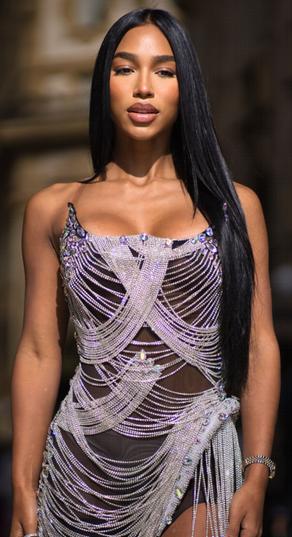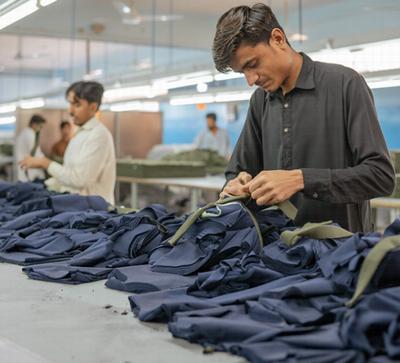Harmonizing Fashion Sense and Sustainability

By Sunny Lewis for Maximpact
NEW YORK, New York, September 19, 2023 (Maximpact.com Sustainability News) – September is a month clothed in glamour in Europe and New York, as the runways fill with the latest ideas from the fashion world’s most talented designers. Fashion weeks open and close on a year-round calendar these days with major shows not only in New York, London, Milan and Paris but also in Dubai, Sydney, Lagos, Accra, Los Angeles, Berlin, Madrid, Rome, São Paulo, Shanghai, Mumbai, Seoul, and Tokyo, among and many other centers.
Still, New York Fashion Week is special, and it ran from September 8-13, showing garments for spring-summer 2024 from 70+ designers. London Fashion Week followed from Sept. 15-19, with Milan Fashion Week opening Sept. 19 and running through the 25th, when the spotlight will turn to Paris Fashion Week through October 3.
“New York Fashion Week is an integral part of New York City’s vibrant culture and sense of constant evolution and discovery,” said Steven Kolb, CEO, Council of Fashion Designers of America. “This season’s official New York Fashion Week schedule plays to this sentiment and will once again showcase the best of American fashion, both emerging and established. We’re excited to see the return of Ralph Lauren, Jonathan Cohen and 3.1 Phillip Lim to the New York runway, adding to the week’s energy.”

Returning brands include Brandon Maxwell, Carolina Herrera, Christian Siriano, who is featured on Bravo TV’s “Runway;” eco-designer Collina Strada who stirred controversy in February when her models paraded the runway in life-like animal protheses; COS, Dion Lee, Eckhaus Latta, Elena Velez, Gabriela Hearst, Jason Wu, Khaite, LaQuan Smith, Michael Kors, Palomo Spain, Prabal Gurung, Proenza Schouler, PuppetsandPuppets, Sergio Hudson, Theory, Tibi, Tory Burch, Ulla Johnson and Willy Chavarria.
Hot trends in New York were big, drapey shoulders, combat boots and the highest of heels, fiery hues of red, and roses on fabrics everywhere. Skin of all shades was on view with sheer textiles and fishnet displaying the bodies beautiful. Designers Christian Siriano, Prabal Gurung and Dion Lee all showed ensembles sans pants, and many designers featured barely-there tops.
Cyril Verdavainne, the founder and designer of his eponymous label, said, “I wanted to show something glamorous and generous in proportion but with clean, crisp lines. The use of colors was a must for me with the neon yellow, the chartreuse, the shameless fuchsia pink… it’s all about bringing fun to our clients’ wardrobes.”
But fun and glamour aside, it’s not simply shape, color and concept, fabric flow and feel, or innovative use of materials that fashion houses and individual designers must think of as they prepare their lines for the coming seasons – it’s sustainability.

The environmental impacts that result from producing an estimated 100 billion garments and 92 million tons of waste each year are substantial.
These facts worry Arabella Ruiz. A senior researcher at The Roundup, <https://theroundup.org/> a guide to green and eco-friendly lifestyles, Ruiz lives in San Antonio, Texas and has worked to improve the environment for years.
On The Roundup website, she presents these and other facts that keep her up at night, writing, “The problem of fashion waste affects our climate, our ecosystems, and our health.”
“The world produces 92 million tons of textile waste every year,” Ruiz writes. “China (20M Tons) and the US (17M Tons) produce the most. Clothing and textiles currently make up at least 7% of the total amount of waste in global landfill space.”
“Between 80 and 100 billion new clothing garments are produced globally every year,” she explains, adding that “87% of the materials and fibers used to make clothing will end up in either incinerators or landfills. Only 20% of discarded textiles are collected. Only 1% of clothes will get recycled into new garments.”

Drawn from the Hong Kong nonprofit Earth.org’s Fast Fashion & Textile Waste Statistics, these are not the only troubling facts.
“$500 billion is lost each year because of under-wearing and failure to recyle clothes,” reports Earth.org. “The worst aspect of our reckless thrown-away culture is that the vast majority of clothes being tossed each year is not recycled. Globally, just 12% of the material our clothes are made from and inadequate technologies to recycle them.”
“The fabrics we drape over our bodies are complex combinations of fibres, fixtures and accessories. They are made from problematic blends of natural yards, man-made filaments, plastics and metals,” writes Earth.org.
“Sustainability: The Future of Fashion, ” a 2022 White Paper from DeSL, Discover e-Solutions Ltd, of Cardiff, Wales, UK, declares, “Sustainability is no longer optional.” <https://www.desl.net/wp-content/uploads/2022/07/DeSL-Sustainability-White-Paper.pdf>
DeSL, a provider of product lifecycle management software for the retail, fashion, apparel, textile, and footwear industries, predicts, “Going forward, brands and retailers will be asked to show how they are tackling climate ensuring compliance with social and human rights requirements, not just in their organisations, but, more importantly, their entire supply chain, from fibre to finished product.”
The Fashion Industry’s ‘Bitter Truth’

“The bitter truth about the fashion industry is that it is one of world’s most significant contributors to carbon emissions and waste. Analysts have estimated that the global fashion industry emits more carbon than the combined economies of France, Germany, and UK [McKinsey]. Valued at close to 3 trillion dollars, the textile and garment industries represent an immense global system [Fashion United]. And with the booming growth, draws greater attention to the negative impacts it is responsible for,” the DeSL White Paper states.
“There are many ways that brands and manufacturers can work together to reduce the negative climate impacts such as: minimizing waste, switching to renewable energy, biodegradable packaging, more efficient transportation, reducing physical samples as well as researching and developing more sustainable materials,” DeSL advises.
“With the global shift centering on sustainability, many groups are putting together guidelines and systems for tracking and monitoring improvement moving forward,” the Welsh company says. “The U.S. Cotton Trust Protocol brings verifiable standards to material production, which closely aligns with the United Nations Sustainable Development Goals.”
Launched in 2020, the U.S. Cotton Trust Protocol says it is built on a foundation of “robust data capture, aggregation and reporting that drives continuous improvement across six key sustainability metrics – water use, energy efficiency, greenhouse gas emissions, soil conservation, soil carbon and land use – and is the world’s first sustainable cotton fiber program to offer article-level supply chain transparency.”
More than 40 global brands and retailers have become members, including Levi Strauss & Co., Ralph Lauren, Gap Inc. and UK retailers Next Plc. and Tesco. This week, the giant retailer Macy’s joined the Protocol with its brands Bloomingdale’s and Bluemercury.
The U.S. Cotton Trust Protocol has over 1,100 mill and manufacturer members from 30 countries including Bangladesh, Cambodia, China, Colombia, Dominican Republic, Ecuador, Egypt, El Salvador, Guatemala, Haiti, Honduras, India, Indonesia, Japan, Kenya, Korea, Mexico, Nicaragua, Oman, Pakistan, Peru, Philippines, Portugal, Sri Lanka, Taiwan, Thailand, Tunisia, Turkey, the United States, and Vietnam. Grower participation doubled to an estimated 1.1 million acres during the Protocol’s second year.
The Protocol is aligned with the United Nations Sustainable Development Goals, recognized by Textile Exchange and Forum for the Future, and is part of the Sustainable Apparel Coalition, Cotton 2025 Sustainable Cotton Challenge, Cotton 2040, and Cotton Up initiatives. It has also been recognized and published in the ITC Standards Map, recognized as a standard for sustainable cotton by the Partnership for Sustainable Textiles, and confirmed as an ISEAL Community Member.
DeSL wrote, “Designing in circularity, along with the latest technology available, brands and retailers can take real steps forward in their goals to make the fashion industry a much more sustainable and ethically aware sector. Sustainability is no longer optional.”
Polluting emissions that affect the climate, air and water quality are produced and every stage of the making and distribution of garments, according to the environmental sustainability consultancy Quantis based in Zurich, Switzerland.
An estimated 12% of these emissions happen during fiber preparation, 15% during fiber production, 28% during yarn preparation, 36% in the dyeing and finishing processes, 7% during assembly of the garments and just 1% during product distribution, Quantis calculates.
Sandra Capponi, co-founder of the fashion brand sustainability ratings firm Good On You, wrote on the Sustainable Apparel Coalition Blog on August 24, <https://apparelcoalition.org/blog/greenhushing-is-a-dangerous-step-backwards-for-consumers/> “The way forward is for brands, retailers, and manufacturers to collaborate on publishing verifiable data about direct operations and supply chains – covering everything from where and how clothes were made, to what resources were consumed, and how much pollution and waste was produced right across their life cycle.”
“As a board advisor on transparency for the Sustainable Apparel Coalition (SAC) I’m advocating for brands to prioritize taking steps towards this. And, of course, transparency alone is not enough. We must bring stakeholders from all sides together, to align efforts and co-create solutions. Demonstrating progress against commitments is even more important to ensuring critical progress is being made over time, and industry bodies like the SAC have an important role to play to catalyze collective action and drive tangible impacts at scale.”
“As the window in which we can act on the climate crisis rapidly closes, brands and retailers cannot be allowed to shirk their responsibilities to both people and the planet,” blogged Capponi. “By not being transparent on their impacts, companies are choosing to set the sector on a path of no return. And this is not a viable option.”
UK Invests £6 Million in Fashion Sustainability Research
A £6 million UK investment announced August 14 will support the fashion and textile industry as it integrates more sustainable and responsible practices.
The industry is estimated to be worth £21 billion to the UK economy, and provides more than half a million jobs. But globally, it is estimated that the sector causes eight percent of global greenhouse gas emissions and 20 percent of wastewater.
“Fashion uses more energy than both aviation and shipping combined,” the British Government said announcing the research funding. “The complexity and reach of the industry means the true impact on the environment is not fully understood.”
Caroline Rush, CEO, British Fashion Council, said, “The British fashion industry leads in creativity and its founders and entrepreneurs are leading innovators in their field. However, in order to responsibly grow businesses at a time of great change requires platforms, support and co-ordination. We look forward to working with industry and government to support the UK in retaining its reputation as creative leaders in a global industry and to develop its ability to responsibly and collectively address how we accelerate to a leading Circular Fashion Eco-System in the UK.”
UK Research and Innovation (UKRI) has funded three complementary networks of researchers, working in partnership with industry experts and other stakeholders, to build a bank of data and knowledge, and support the sector in adopting sustainable circular business models.
1 – The Back to Baselines in Circular Fashion and Textiles Network is being led by the University of Leeds. It will establish a baseline to analyse the current status of sustainability practices in the industry.
2 – Future Fibres Network is being led by the University of Exeter and aims to embed environmental sciences at the heart of fashion, wider apparel, and textile sectors, and establish systematic, circular and sustainable principles as the industry norm.
3 – Led by Northumbria University, the IMPACT+ Network will assemble a cross-disciplinary team to improve the collation, analysis and assessment of data to advance the reliability and authenticity of environmental impact measures
“The fashion industry makes a significant contribution to the UK. But it also impacts the environment, including using water resources and causing emissions of greenhouse gases. We need to better understand the true impact,” Professor Peter Liss, Interim Executive Chair of the Natural Environment Research Council, part of UKRI, said. “This investment will bring together industry experts and researchers in environmental science and fashion to embed sustainability in the fashion and textile industry.”
Adam Mansell, CEO, the UK Fashion and Textile Association, said, “Sustainable manufacturing and recycling infrastructure will be key drivers in the move to a circular fashion ecosystem here in the UK.”
Funding of £6 million has been awarded by the Natural Environment Research Council, the Arts and Humanities Research Council and Innovate UK, all part of UKRI. This investment is a key part of UKRI’s £15 million Circular Fashion Programme.
How Much Waste is Good for the Fast Fashion Industry? Zero!
In Brussels earlier this month, a new paper by Zero Waste Europe is demanding a concentrated effort by governments to bring the fashion textile sector back into harmony with planetary boundaries.
Entitled “A Zero Waste Vision for Fashion” the study <https://zerowasteeurope.eu/library/a-zero-waste-vision-for-fashion-all-we-need-is-less/> examines the building blocks for a sustainable transition in the fast fashion industry. Central interventions are a ban on the destruction of unsold goods, targets on waste prevention and resource use as well as financial incentives for producers.
The global shift from a linear economy to a circular one could be the answer to combating the overconsumption of natural resources. But addressing this challenge also requires an overall reduction of material use. Policymakers must recognise major polluters’ market influence and move beyond blaming consumer choices.
Theresa Mörsen, author of the report and Waste and Resources Policy Officer at Zero Waste Europe, said, “We cannot rely on so-called consumer behaviour ‘nudges’ to cut down on fashion consumption. The cause of our current waste crisis lies with the fast fashion business model that relies on selling large volumes of trendy items. We must have a robust regulatory framework that allows consumers to live well – and dress well – within planetary boundaries.”
The paper’s three pivotal interventions for policymakers are to: enforce legal frameworks that work, drive change through financial incentives, and spread awareness about the sufficiency wardrobe.
The paper suggests setting a target for textile waste reduction of one-third by the year 2040 in comparison to 2020.
It calls on the European Union to transform its waste legislation into a Resource Framework Directive in line with the 1.5-degree climate target of the Paris Agreement.
“A series of initiatives could be integrated to reshape industries, such as Extended Producer Responsibility (EPR) programs that promote prevention, repair, and reuse as well as imposing environmental taxes on virgin materials, particularly virgin plastics,” Zero Waste Europe advises.
In recent years, the rapid growth in the fast fashion sector was fueled by cheap synthetic fibres from fossil resources and manufacturing in regions with lax labour and environmental standards. Setting the price right is an essential lever to address this.
But a culture of sufficiency with restrictions on fast fashion advertisements and more attractive repair and reuse for consumers and businesses, is needed for the transition to succeed.
“While the textile sector’s transformation is a critical milestone,” Mörsen said, “it’s important to recognise that it’s only part of a broader economic shift toward sufficiency, well-being, and resilience.”